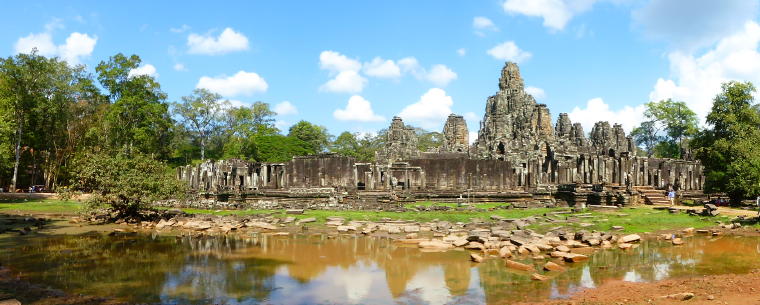|
|
|
|
|
Carsons in front of Angkor Wat. Angkor Wat
was built between 1113 and 1150 AD and is the largest religious
building in the world.
|
|
The complex was originally dedicated to
the Hindu god, Vishnu. The five towered temple is shaped like
a lotus bud and represents Mount Meru, the mythical abode
of the gods.
|
|
|
|
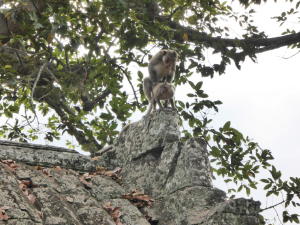 |
|
We were greeted by a few monkeys.
|
|
|
|
|
|
|
|
Surrounding the towers are four long galleries
with bas relief carvings.
|
|
The carvings depict Hindu epics in great
detail as well as the life of the king who built the temple.
|
|
|
|
|
|
The carvings are the longest bas relief
in the world and are in amazing condition.
|
|
|
|
|
|
|
|
|
|
|
|
|
|
|
|
|
.
|
|
|
|
|
|
|
After looking at the bas reliefs on the
first level, and wandering around the second level, we climbed
up steep steps to the third level to the central sanctuary
for a nice view of the complex and an up close look at the
towers.
|
|
|
|
|
|
|
The 4 entrances to the sanctuary feature images of Budddha,
reflecting the Buddhist influence that eventually displaced
Hinduism in Cambodia.
|
|
Apsaras - celestial dancing girls - line
the walls of the temple. Holding alluring poses, they are
shown wearing ornate jewelry and exquisite headgear.
|
|
|
|
|
|
|
|
It was a steep descent.
|
|
|
|
|
|
|
Angkor Wat is surrounded by a huge moat,
570 feet wide.
|
|
|
|
|
|
|
|
|
|
|
|
|
|
|
Entrance to Angkor Thom
|
Angkor Thom was the capital city of the
Khmer rulers until the 17th century. Built in the late 12th
century, it covers nearly 4 square miles.
|
|
|
|
|
|
|
The Bayon inside Angkor Thom was our favorite
of the ruins. It contains 37 towers (originally there were
54). Each tower has 4 faces carved on the sides.
|
The faces are said to depict a Hindu god,
a Buddhist god or the king himself.
|
Our guide had fun taking pictures of us
rubbing noses with the gods!
|
|
|
|
|
|
|
|
The bas reliefs along the gallery walls
depict the life of the people and images of battles.
|
|
|
|
|
|
|
|
|
|
|
|
|
|
|
|
|
|
|
|
|
|
|
Lunch Time.
|
|
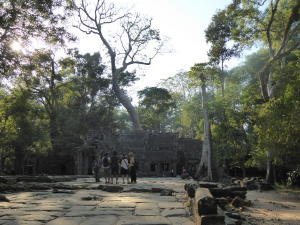 |
|
|
|
Visit to Ta Prohm.
|
Ta Prohm has been left the way it was found,
covered by a dense jungle of trees and roots. This gives visitors
an idea of what it might have looked like when it was discovered
by the French in the mid 1800's.
|
Strangler figs, and strung (kapok like tree)
are entwined among the ruins. The roots are such an integral
part of the structure that they are actually holding it up
in many places.
|
|
|
|
|
| |
|
|
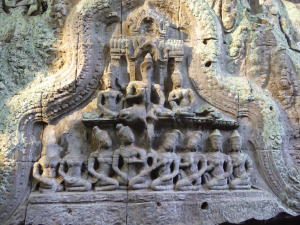 |
|
 |
| |
|
|
|
|
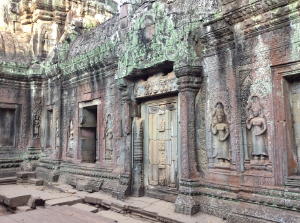 |
 |
| |
|
|
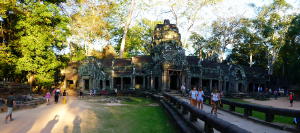 |
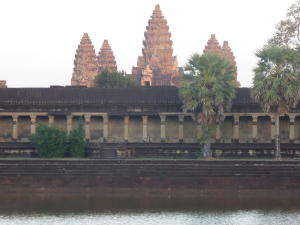 |
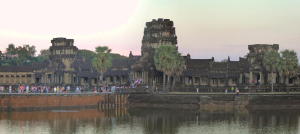 |
| |
We went back to Angkor Wat to watch the
sun set from across the moat.
|
|
